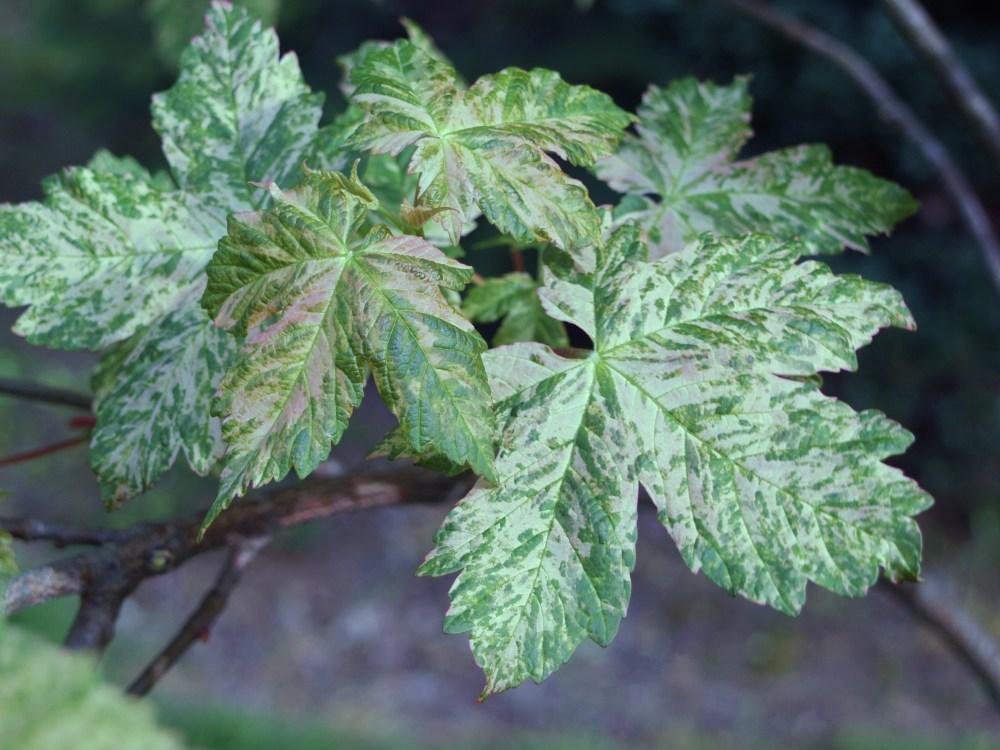In the past week there has been one storm after the other, and the forecast is for more of the same in the next few days. The lower part of the garden is saturated, and mostly the plants in this area are well adapted to damp soil, so there is little harm to be done by areas of standing water for a few more days.
A variegated hybrid dogwood (Cornus x ‘Celestial Shadow’, above) recently succumbed to the constant moisture, and I blame myself for poor judgement in planting where I should have known it was too wet. My reasoning is not important at this point, but I planted the dogwood in late summer a few years ago when the area was far drier, and I planted it high in a raised bed to allow for some additional drainage. It survived a year, but it grew weakly, and it would have been better to transplant the dogwood to a drier spot before the problem reached this point. But, you say that things happen for a reason, and I know why this occured; I’m lazy and sometimes I give plants credit for being tougher than they really are. Oh well, another lesson learned, and fortunately I planted two others in more suitable spots.
A variegated Sycamore maple (Acer pseudoplatanus ‘Eskimo Sunset’, above) and a few evergreens barely tolerate the dampness, and eventually I’m likely to replace these with something else, though I don’t know where I’d transplant the maple to. Now, the small tree is in the middle of a small section of lawn in the lowest area of the garden behind the large koi pond. When I planted it, there seemed nowhere else with suitable space or sunlight, so it’s stuck where it’s in the way of the mower, and if it would happen to eventually take off and start growing it will block foot traffic also. I incorrectly figured that a maple would better tolerate the moisture, but somehow I didn’t consider that the tree would be so much in the way.
The death of the dogwood is clearly a failure on my part, and the maple a disappointment, but other plants thrive in the moist soil. Native Indian pinks (Spigelia marilandica, above) are quite happy in damp ground, though one clump is at the edge of a spot that suffers a bit of erosion in a deluge, so I must watch to make certain that it isn’t uprooted and washed away. In a drier location the pinks grow slightly taller, and the stems are less supple so that they flop a bit, but not so much as to be a problem. The trumpet shaped flowers are red on the outside, and the contrast with the flared yellow tips is striking, though Indian pinks will never be noticed from more than a few paces away. Not every plant must be obvious in bloom to automobiles speeding down the highway, and most exceptional plants are not.
Wood sorrel (Oxalis crasippes, above) is thriving in damp or dry spots, and I’ve discovered there is no need for the caution I exercised in not planting it for too many years, fearing it would spread rampantly and be too aggressive. This variety is a pleasant clumper, and it blooms from late spring through autumn in sun or part shade with hardly a break. On hot afternoons it wilts a bit in dry ground, but it quickly springs back and looks perfectly content the next morning. In damp soil (though not standing water), it is overjoyed.
I’m in northern VA, too, and also have a few plants that are tired of the rain. My spigelia are thriving, too. But the agastache and oregano are on the verge of calling it quits. I’ve never seen a variegated sycamore maple. Very cool leaves!
After having several plants drown in a corner of my backyard where water collects after a storm, I decided to search out a few “flood tolerant” plants. I’ve run across conflicting information, but settled on Winter Red Holly, Henry’s Garnet Virginia Sweetspire, Sweet Kate Spiderwort, Great Blue Lobelia and Golden Creeping Jenny. Maybe all a little random. Do you think these will all survive several days of standing water? Are there other perennials you’d recommend? Thanks!
In the dampest areas of my garden I’ve planted rodgersia, bloody dock, acorus, creeping Jenny, and Japanese iris. All are thriving, and I’m certain there are more that will do well in these conditions. The shrubs you’ve listed should do fine, and I’ve planted natives buttonbush and aronia.